Promoting Youth Development
Fuji Electric works with the local Board of Education to make use of the personnel and technologies it has developed in business to teach children the joy of science and plant the seeds for the next generation of engineers.
As one means of regional contribution, Fuji Electric holds science classrooms at each location. The plan is to teach children, who are growing disinterested in science, the joy of science and how to think with a scientific mind. Fuji Electric held a science classroom at its Facility Technology Center in Konosu, Saitama Prefecture, as one of the courses provided during “Kinder-Uni Konosu,” an educational event run by the prefecture and its cities in the summer of 2017. The Center was also used to hold the Kinder-Uni Konosu entrance ceremony. How did the children react to this public-private joint effort? Here, we provide some information on this effort mixed with reactions from people from the area.
Wanting more people from the area to see the Facility Technology Center
“The Fuji Electric Facility Technology Center had previously been involved with various regional activities, such as regional and prefectural cleaning efforts, cooperative efforts in park greening, and support during fireworks events. We were thinking of how we could conduct a science classroom—something we’ve never done before—as Fuji Electric as a whole attempts to expand support for developing the next generation. I mentioned this to a city councilor I met through our regional activities and he suggested conducting the class during Kinder-Uni, so he introduced the Konosu Board of Education to us as a point of contact.”
So explains Hiroe Niijima, a Supervisor in the Saitama Region Administration Section who was responsible for this plan in the Center. Kinder-Uni is an event that includes classroom lectures and hands-on activities held in cooperation with Saitama Prefecture and each city/town/village or municipality, with the goal of developing intellectual curiosity in children. Classes are conducted by university professors and other experts in university campuses and other locations. In only its fifth year since being established, the Facility Technology Center has plenty of technology as a manufacturing location, and is also used as an educational site for technical skill training. It therefore seemed to be most suitable as a location for Kinder-Uni.
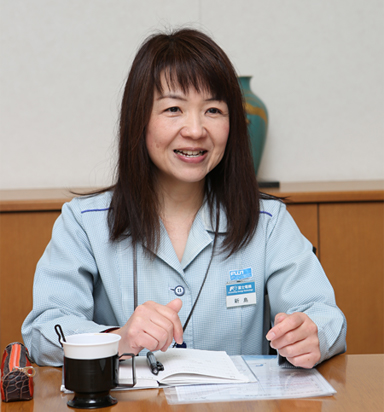
Hiroe Niijima, Saitama Region Administration Section Supervisor
The Center has continued to operate from a position of stability thanks to regional understanding and trust, so there was a desire for more people from the area to get a look at the Center. It was decided to not only conduct a science classroom there as one of the lessons during the event, but to also hold the 2017 Kinder-Uni Konosu entrance ceremony there and provide lunch after the class.
These were all brand new experiences and there were a lot of issues to resolve.
First was accepting the students. “There were around 60 elementary school students participating. If we include their parents and guardians, that brings the total to 120. We’ve never had so many visitors at once before. We had to assume that everyone would come by car, so we had to ensure enough parking space for 60 vehicles and even had to think of how to guide people from the parking area to where the event was being held.”
Staff next tackled preparing lunch for visitors. A range of related issues needed to be cleared, such as confirming any visitors with food allergies. In total, 200 curry lunches (sweet so that even children could eat them) were prepared for children and their parents/guardians. “Our cook wasn’t sure how to flavor the meals for kids. We also had to keep sanitation in mind, so it’s not like we had nothing to worry about when it came to serving lunch. But we didn’t just want to teach kids science; we also wanted them to look back on this as a fond summer vacation memory. That’s why we thought that having everyone eat lunch together was so important. In the end, lunch was a big hit with kids and their parents and guardians alike... and we even had one kid who ate five dishes!”
The greatest pleasure was seeing the lively expressions on children’s faces
A lot of work went into conducting the class. The script for the program was arranged to get the children interested. During the experiment (which involved using wind from an attached propeller to move a wheel, with the waterwheel representing a motor and water representing energy), three instructors performed a comedic skit, with one as the science doctor, another as his assistant, and the third providing a more grounded explanation. Yoshinobu Suda, a Supervisor in the Facility Technology Division, Element Technology Development Section, was chosen to play the science doctor. Yohei Hori, from the Facility Technology Division, Facility Design Section, was chosen as his assistant. Neither of them normally teach children. Yuji Kariya, Electronic Devices Training Supervisor at the Technical & Skill Training Dept., was selected to explain the experiment as his normal job involves training and education.
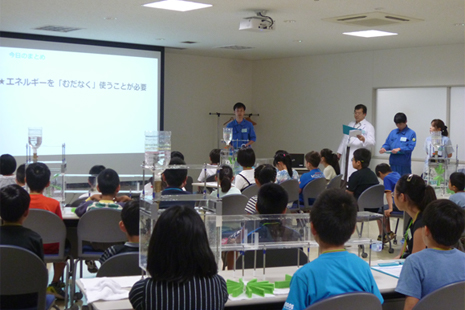
The science classroom
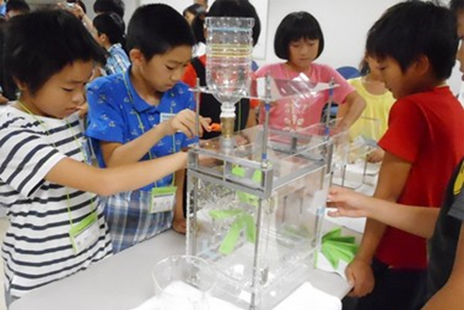
The experiment used water and a waterwheel
Mr. Suda explained his role.
“I performed my role as science doctor complete in a white lab coat (laughs). I was told by some coworkers to make it fun for the kids, so I made sure to keep smiling. The kids were really serious about learning, and the reaction was great. I thought it might be difficult for them to understand environmental issues, but all the kids seemed really interested to hear what we had to say.”
Mr. Suda was concerned about the lack of interest in science among children—even his own. He went on to explain the significance of conducting experiments in which students actually get to use instruments.
“When I was a kid, I used to take apart anything I could get my hands on, including my toys. I often got yelled at by my parents! But I think doing that helped make me the engineer I am today. I think it’s important to actually get your hands on things and see how they work.”
Mr. Hori also feels that the good reactions from the children helped make the class a success.
“During the rehearsal, I was really nervous because the adults didn’t look like they were having fun. I honestly felt a bit embarrassed when it came to the real event, but seeing the lively expressions on the kids’ faces helped get me through it.”
Mr. Kariya also shared his experience.
“I was friendly with the kids and tried to get them to have fun. Of course, I’m normally strict when training students at the Training Dept. (laughs). I was most concerned about safety. Kids these days don’t really play much with physical toys, so I was worried that they might get hurt handling the laboratory instruments. We decided to assign a staff member to each group to keep things safe.”
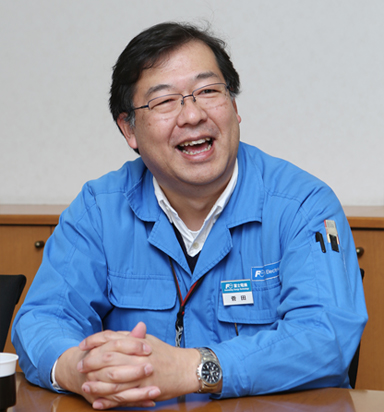
Yoshinobu Suda, Element Technology Development Section Supervisor
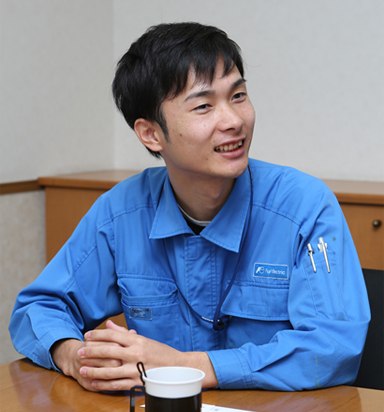
Yohei Hori from the Facility Design Section
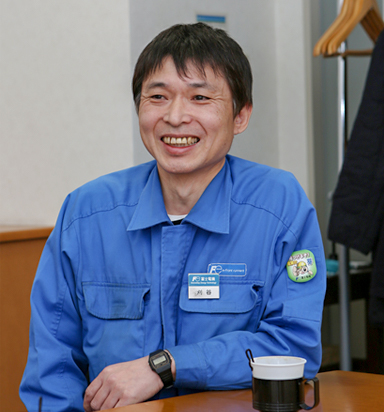
Yuji Kariya, Technical & Skill Training Dept. Electronic Devices Section Training Supervisor
The importance of continuing each year
Takuro Kajiwara, Saitama Region Administration Section Manager, had the following to say about the methods they developed during the first science classroom.
“We first wondered how it would go. This was our first time meeting all these kids from schools in areas throughout the city, and we were worried that everyone would be nervous and sit in absolute silence in the classroom. Instead, the kids were friendly right off the bat and actively worked with us during the experiment. It was like the adults were energized by the kids. I was truly pleased when reading the feedback to see that some kids wrote that they wanted to become engineers when they grow up. I hope they really will become engineers... and come work for Fuji Electric!”
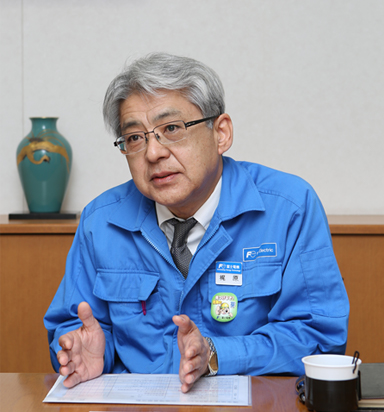
Takuro Kajiwara, Saitama Region Administration Section Manager
The Board of Education was also pleased with the event. Ms. Niijima explains.
「“They asked us to do it again next year. So now we’re thinking about a different class for then. Kids from three grade levels—fourth year to sixth year students—all participate together in Kinder-Uni Konosu, so we might see some of the same kids again next year. That means we can’t do the same class.”
It may have been a lot of work to prepare the program, but it was well worth it. Working with Kinder-Uni Konosu run by the government has made it possible to continue supporting the development of the next generation every year.
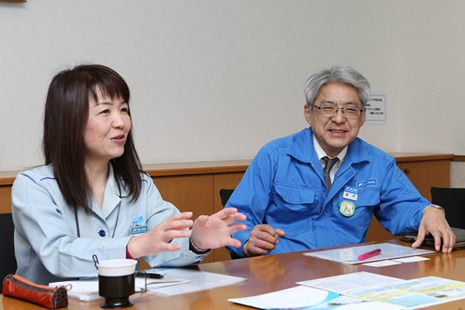
There is also an increasing need for programming education, so that more students can understand how the computers that are increasingly used throughout society wo
“We were also asked by the Board of Education to tackle programming next time, so we’re looking into that. We’d like to keep doing this each year, while covering the needs of both kids and their parents and guardians. I think the real significance of doing these regional contribution activities is to make people happy by covering regional issues and needs.”
■Click below for more information on efforts to develop the next generation at Fuji Electric
http://www.fujielectric.co.jp/about/csr/social_action_program/training.html


